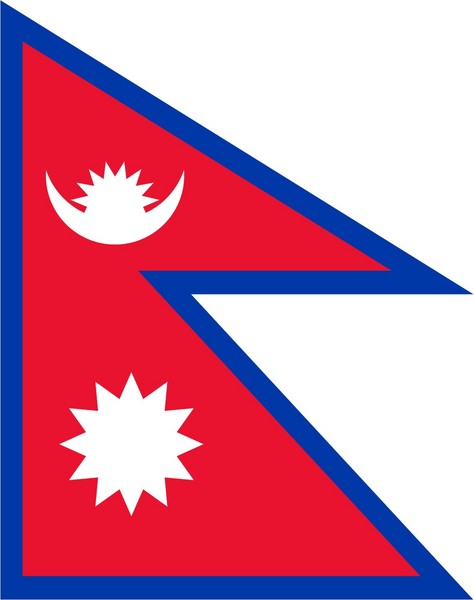Interesting Nepal Facts
Nepal is a landlocked country located in Southern Asia where it is bordered by China and India. It spreads over 147,181 km2 of land. The estimated overall population of Nepal is in excess of 29,503,357.
Learn interesting Nepal facts and information about this Asian country with our fact file for kids. Explore important facts about the geography, landscape, landmarks, flag, population, size, continent, language, people, culture, climate, currency and location of Nepal.
Discover Asia with our interesting Nepal facts for kids based on questions such as: What continent is Nepal in? What are the major cities of Nepal? What is the capital city of Nepal? How big is Nepal? What is the climate like in Nepal?
Nepal Fact File: Continent: Asia * Country Name(s): Nepal, Federal Democratic Republic of Nepal * Location: Southern Asia * Bordering: China and India * Capital City: Kathmandu * Size: 147,181 km2 * Estimated Population: over 29,503,357 * Currency: Nepalese rupee (NPR) * Language(s): Nepali * Country Code: +977
Interesting Nepal Facts for Kids
Interesting Facts for Kids 1: Size & location facts
Nepal belongs to the continent of Asia, where it has a landlocked position and is bordered by China and India. There are seven continents in the world: Asia, Africa, North America, South America, Europe, Antarctica, Australia (Oceania). Asia is the world's largest continent, spanning a total area of 43,820,000 km2. Asia has 48 countries, with some countries belonging to both Asia and Europe, and forms 29.5% of the world's landmass. Nepal is a landlocked country that covers a total area of approximately 147,181 km2. It is a small to medium sized country located on the mainland continent of Asia in the Himalayas.
Interesting Facts for Kids 2: Population facts
The population of this Asian country is thought to be more than 29,503,357 people. The majority of Nepal's inhabitants reside in Kathmandu which is the country's most populous city. Nepal has a fairly high population when compared to most other countries across the world, its overall population density is approximately 194 people per sq km. The estimated population of Asia is approximately 4,393,296,000 inhabitants, making it the continent with the largest population in the world. The continents in order of population, starting with highest population first, are: Asia, Africa, North America, South America, Europe, Australia (Oceania Region) and Antarctica. The total population of the entire world is in excess of 7.6 billion people.
Interesting Facts for Kids 3: Capital & major cities
The capital of Nepal is Kathmandu. The names of other major cities located in this country are Pokhara, Patan, Biratnagar, Birgunj and Dharān.
Interesting Facts for Kids 4: Country borders
The following guideline provides details on the approximate border lengths of Nepal:
China 1,389 km, India 1,770 km.
Interesting Facts for Kids 5: Climate and geography facts
The climate of Nepal varies between northern and southern regions. In the south, the climate can be described as being subtropical with warm summers and mild winters. In the north, the climate is cooler with mild summers and very cold winters. The geography of Nepal is characterized by hilly areas and high mountainous regions, namely the Himalayas which encompasses Mount Everest and Kanchenjunga, the highest and third highest mountains on Earth. The low lying land at the foot of the Himalayas is known as Terai. There are three major rivers that are tributaries of the Ganges in the south, they are the Koshi, Gandaki and Karnali. The lowest point of Nepal is the Kanchan Kalan at 70m, and the highest point of elevation is Mount Everest at 8,848m.
Interesting Facts for Kids 6: Natural Resources of Nepal
Natural resources are materials and substances that can be found occurring naturally on Earth. Natural resources are very important across the world, and can be exploited for economic gain. The level of natural resources present in an individual country depends on varying factors which are influenced by the geography, climate and location of that country. Some countries, such as Russia, The United States, Saudi Arabia and Canada, have many natural resources, where as some other countries have limited to none. Food, transport and construction are three of the primary uses of natural resources. For example, fish is a naturally occurring resource that can be caught for food consumption. Crude oils can be refined into different types of fuels in order to power vehicles/cars. Wood/timber from forests can be used to build homes and furniture. The natural resources of Nepal include quartz, water, timber, hydropower (water power), scenic beauty, lignite, copper, cobalt and iron ore.
Interesting Facts for Kids 7: Language facts
The official language of Nepal is Nepali. The languages of Maithali, Bhojpuri, Tharu and Tamang are widely spoken in Nepal. Other languages spoken by a small percentage of the population include Bajjika, Newar, Urdu, Avadhi, Magar, Limbu and Gurung.
Interesting Facts for Kids 8: Religion facts
The primary religion of Nepal is Hindu at approximately 81% of the population. Around 9% are Buddhist, 4% Muslim, 3% Kirant, 1% Christian.
Interesting Facts for Kids 9: Symbols of Nepal
Each country has its own individual culture, history and identity. Flags, emblems, symbols, mottos, colors, anthems and songs represent the national pride and identity of countries worldwide. These national symbols are formed through the unique history of a nation and are symbolic of both hardship and prosperity, embodying freedom, strength and unity. Flags, emblems, songs, mottos and colors reflect the past, present and future hopes of a country, and create an important image to the rest of the world. National symbols can include a mixture of things that are symbolic to a country such as animals, birds, flowers, trees, geographical features, tools of agriculture, crops, and tools of war. The following facts depict some of the national symbols, songs and colors that are important to Nepal:
National symbol(s): rhododendron blossom national color: red
National Anthem/Song: Sayaun Thunga Phool Ka (Translation: Hundreds of Flowers)
National Holiday(s): Republic Day, 28 May (2008)
